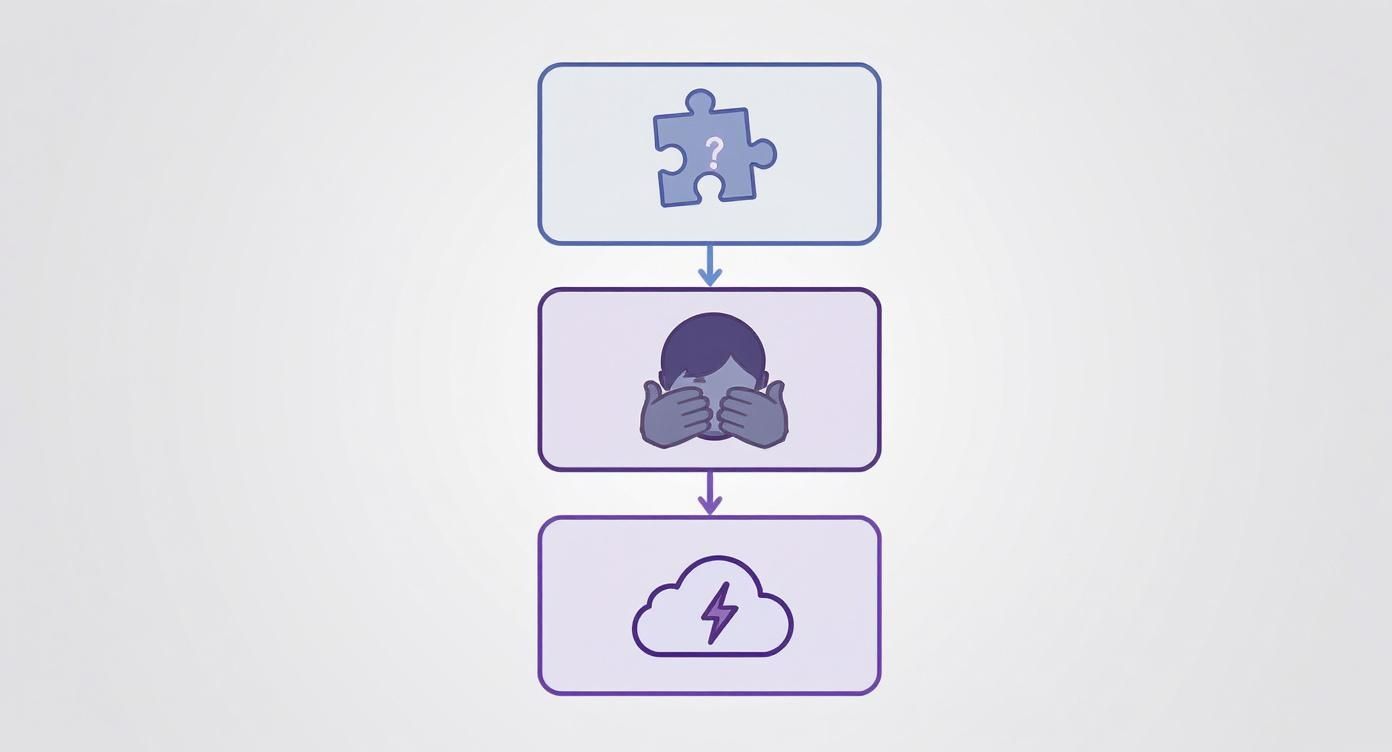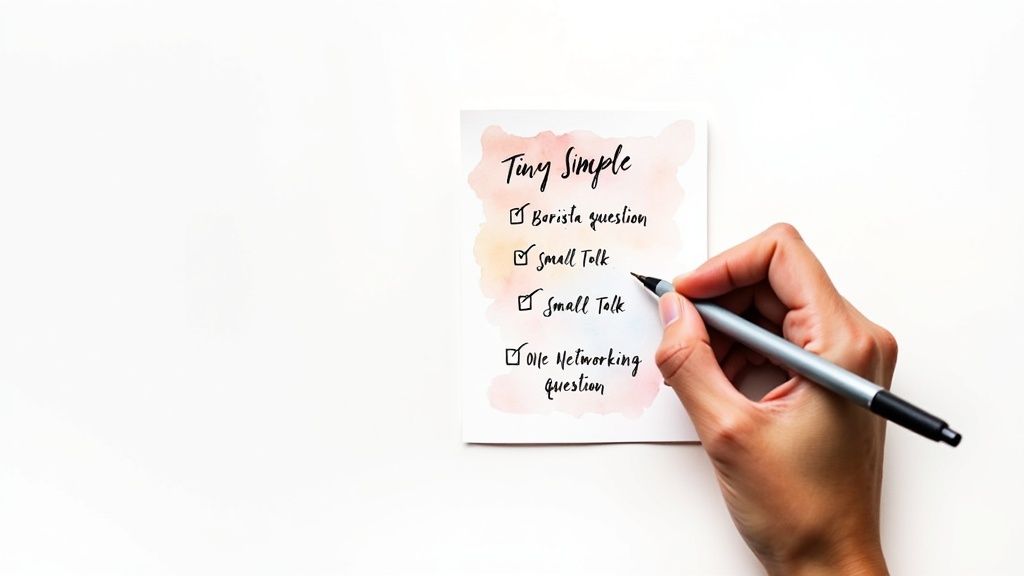Before you can start to feel more comfortable in social settings, you have to get a handle on what's really going on. It's about understanding the key differences between feeling awkward, being shy, and having clinical social anxiety.
Once you can see it for what it is, you can stop blaming yourself. It's not a personal flaw. It's just a set of skills you haven't built up yet—and you absolutely can. Shifting from self-criticism to proactive growth is the first real step.
First, Understand Why You Feel Awkward
Jumping straight into solutions without knowing the root cause is like trying to navigate without a map. Lots of people throw around terms like "socially awkward," "shy," and "socially anxious" as if they're the same thing, but they’re not. They describe very different experiences.
Figuring out which one fits you best is your first move toward making real progress. You can't fix a problem if you don't know what it is.
This isn't about slapping a negative label on yourself. It's about getting clear. Think of it like a doctor figuring out if you have a cold or the flu—the diagnosis determines the treatment. In the same way, understanding your specific social challenges helps you focus on strategies that will actually work for you.
What's The Difference Between Awkwardness, Shyness, and Anxiety?
Social awkwardness usually comes from a temporary mismatch between what you do and what's expected in a social situation. It’s that cringey moment when you tell a joke and hear crickets, or you completely misread someone's tone. We've all been there.
Shyness, on the other hand, is more about a feeling of nervousness or timidity around other people. It’s often rooted in a fear of what they might be thinking about you.
Social anxiety is a whole different level. It’s a persistent, intense fear of being judged, watched, or humiliated. This isn't just a minor case of the nerves; research shows it's a major global issue. A 2020 study found that a staggering 36% of young people met the clinical criteria for Social Anxiety Disorder. That number really puts into perspective how common these intense feelings are.
The infographic below breaks down the distinct characteristics of each.

This visual guide helps clarify that while these experiences might feel similar or even overlap, they come from different places and need different approaches to manage.
To make it even clearer, let's look at these three side-by-side. Understanding the nuances can be a lightbulb moment, helping you pinpoint exactly what you're dealing with.
Key Differences: Awkwardness vs. Shyness vs. Social Anxiety
| Characteristic | Social Awkwardness | Shyness | Social Anxiety Disorder |
|---|---|---|---|
| Core Feeling | Confusion or misreading social cues | Fear of negative judgment or evaluation | Intense, persistent fear of scrutiny |
| Duration | Situational and temporary | Consistent across many social situations | Pervasive and long-lasting |
| Physical Symptoms | Minimal; maybe blushing or stumbling over words | Blushing, increased heart rate, sweating | Panic attacks, nausea, trembling, dizziness |
| Impact on Life | Minor social mishaps; occasional embarrassment | Avoidance of some social events or new people | Significant disruption to daily life, work, and relationships |
| Thought Patterns | "Oops, that was the wrong thing to say." | "They probably think I'm boring/stupid." | "Everyone is judging me. I need to escape." |
This table can be a really useful tool. See which column resonates most with your own experiences. This isn't about self-diagnosis, but about gaining the self-awareness you need to move forward.
Find Your Personal Triggers
Once you have a better handle on these concepts, you can start digging into your personal triggers. Does that awkward feeling only pop up in specific situations, like giving a presentation at work? Or is it tied to deeper thought patterns you've had for a long time?
Sometimes, these feelings are connected to your attachment patterns. It might be helpful to learn more about the symptoms of an anxious attachment style to see if any of that sounds familiar.
For anyone dealing with really severe social discomfort, exploring the connection between OCD and social anxiety disorder could also offer more insight. These conditions can sometimes go hand-in-hand and influence how you interact with others.
Key Takeaway: Getting to the why behind your social awkwardness is the most powerful first step. It turns that vague, heavy feeling of "being bad with people" into a specific, solvable challenge you can tackle with the right mindset and practice.
Navigate Conversations With Less Stress

Let's be real: generic advice like "just be yourself" is pretty useless. When you're wrestling with social anxiety, you don't need a vague platitude; you need a game plan. So, let's get into some concrete techniques that make conversations feel less like a high-stakes performance and more like a genuine connection.
The point isn't to magically transform into a social butterfly overnight. It’s about arming yourself with a few simple tools that take the pressure off and help you find your footing in social settings.
The Observe and Comment Kickstart
Getting a conversation off the ground is often the hardest part. The "observe and comment" method is my go-to for a low-pressure opener. Forget trying to come up with some witty, brilliant line. Just make a simple, neutral observation about the situation you're both in.
Picture yourself at a work conference. You could lean over to the person next to you and say, "This coffee is surprisingly good," or maybe, "I'm really looking forward to what this next speaker has to say." It’s easy, it's relevant, and it opens the door for them to respond without feeling put on the spot.
This little trick works just about anywhere:
- At a party: "This is a great playlist. I wonder who picked the music."
- Waiting in line: "That's an interesting book you're reading. I've heard good things about it."
- At a gallery: "The artist's use of color in this piece is incredible, isn't it?"
The secret is to comment on something you're both experiencing. It creates an instant, low-stakes shared moment, making it so much easier to slide into a real conversation.
Find Common Ground With The FORD Method
Okay, so you've broken the ice. Now what? How do you stop the conversation from dying a slow, awkward death? The FORD method is a brilliantly simple framework for steering the chat toward topics most people actually enjoy talking about.
It stands for:
- Family
- Occupation
- Recreation
- Dreams
These four pillars are safe, universal, and perfect for uncovering common ground. You don't have to be invasive, either. A simple, "Got any fun plans for the weekend?" is a great way to learn about someone's hobbies and passions.
The real magic of conversation isn't about saying the perfect thing; it's about asking the right questions that allow the other person to share something about themselves. This shifts the focus off of you and onto them, which can significantly lower your anxiety.
Practice Active Listening
So many people who feel socially awkward spend the whole conversation rehearsing their next line in their head. The problem? They aren't actually listening. Active listening is all about focusing completely on what the other person is saying—with their words and their body language.
This means putting your phone away, making comfortable eye contact, and giving small verbal nods like, "uh-huh" or "that's interesting." When you truly listen, you'll find that follow-up questions just pop into your head naturally. You're not desperately searching for a topic; you're simply continuing the one they already started.
To really get this down, it helps to build a strong foundation. For more in-depth techniques, you can explore our guide on how to improve conversation skills, which offers even more specific strategies.
Gracefully Exit Any Conversation
Knowing how to leave a conversation is just as important as knowing how to start one. Nothing cranks up the anxiety like feeling trapped. Having a few polite exit lines ready to go gives you a sense of control and a massive confidence boost.
Here are a few phrases you can keep in your back pocket:
- "It was so great talking to you. I'm going to grab another drink before the next session starts."
- "Well, I should let you go, but it was wonderful to meet you."
- "I need to find my friend, but thank you for the lovely chat. Hopefully, we'll run into each other again!"
These simple lines are polite, direct, and kill any awkward lingering. Mastering the graceful exit is a key piece of the puzzle for navigating social events with way less stress.
Master Confident Body Language
Long before you ever say a word, your body is already doing the talking. It’s wild, but non-verbal cues make up a huge part of how people see you. Getting a handle on them can completely change the vibe you give off and how people react to you.
Learning how to stop being socially awkward isn't about becoming someone you're not or putting on an act. It’s about making small, conscious tweaks to your physical presence that signal confidence and openness—not just to others, but to yourself, too.
When your body language says "I'm at ease," your mind has a funny way of catching up. Something as simple as uncrossing your arms can instantly make you seem more approachable. Standing up straight with your shoulders back doesn't just look confident; it can actually make you feel more self-assured.
Project Openness and Confidence
First things first, let’s focus on an open posture. When we get nervous, our natural instinct is to shrink. We slouch, cross our arms, or hunch our shoulders. These are all classic "closed-off" signals that quietly broadcast to everyone around you that you’d rather not talk.
To fight this, you have to be intentional. Practice keeping your posture open. Picture a string gently pulling the top of your head toward the ceiling, which helps straighten your spine without feeling stiff. Let your arms hang relaxed at your sides instead of locking them across your chest.
Key Insight: Adopting a more expansive posture—think "power posing"—doesn't just change how others see you; it can literally alter your body chemistry. Studies have shown these poses can boost feelings of confidence and even lower your stress levels.
Here are a few practical non-verbal cues to start working on:
- Maintain Eye Contact: The goal here is a comfortable balance, not a staring contest. Hold someone's gaze for a few seconds while they're talking, then glance away for a moment before looking back. It shows you're locked in and listening.
- Offer a Genuine Smile: A real smile—a Duchenne smile—involves your eyes. When you meet someone new, try thinking of something that actually makes you happy. It’ll create a warm, authentic expression that puts people at ease.
- Keep Your Head Up: When you walk into a room, make a point to keep your chin parallel to the floor. Staring at your feet signals insecurity, but looking straight ahead projects awareness and a quiet confidence.
Use Mirroring to Build Rapport
Once you're more aware of your own body language, you can start paying attention to others. This is where a powerful little technique called mirroring comes in. It’s all about subtly and naturally matching the other person’s posture or gestures.
For example, if they lean in a bit while telling you a story, you might lean in a bit, too. If they use a hand gesture to emphasize a point, you could incorporate a similar relaxed gesture into your own speech a few moments later.
This isn't about being a copycat. The key is subtlety. When you do it right, mirroring creates a subconscious sense of harmony and connection. It sends the message, "Hey, I'm on the same wavelength as you," which makes the whole interaction feel smoother and more comfortable for everyone involved.
Create Your Social Practice Plan

Think of mastering social skills like building muscle at the gym. You wouldn't walk in on day one and try to bench press 300 pounds. That’s a recipe for failure. Instead, you'd start with lighter weights and work your way up.
The same logic applies here. A solid, structured plan is your roadmap to leaving social awkwardness behind for good, without the overwhelm. The secret sauce is gradual exposure—starting with social interactions that feel totally manageable and slowly leveling up to more challenging ones. This builds momentum and, more importantly, proves to your brain that you can handle this.
Start With Low-Stakes Scenarios
The first step is to rack up a series of small, easy wins. We’re talking about brief, low-pressure interactions where the outcome just doesn’t feel like a big deal. The stakes are low, making them the perfect practice ground.
Look at your daily routine. Where are the opportunities for these tiny interactions? Your goal isn’t to launch into a deep, meaningful conversation. It’s simply to kick off a brief, positive exchange.
Here are a few ideas to get you rolling:
- At the coffee shop: Don't just mumble your order. Make eye contact with the barista and say, "Hope you're having a good morning."
- In the grocery store: Ask an employee where something is, even if you already know. The interaction itself is the win.
- While walking the dog: Give a simple "Hello" to another dog owner you pass.
These tiny steps are way more powerful than they seem. They help you get comfortable with the simple act of initiating, which is often the biggest hurdle to clear when you're figuring out how to stop being socially awkward.
Set Specific and Actionable Goals
A vague goal like "I'm going to be more social" is a setup for failure. It’s impossible to measure and usually ends in frustration. What you need are small, concrete targets you can actually hit. This takes the focus off some fuzzy, intimidating outcome and puts it on a clear action you can control.
A specific goal gives you a clear mission. It removes the guesswork and provides a simple definition of success for each social exercise, making it easier to see your progress and stay motivated.
Let's look at how to reframe those vague goals into something you can actually do:
| Vague Goal | Specific, Actionable Goal |
|---|---|
| "Be better at parties." | "I will ask one person at the party an open-ended question about their weekend." |
| "Talk to new people." | "At the networking event, I will introduce myself to one person I don't know." |
| "Be less quiet at work." | "I will share one relevant idea or comment during our next team meeting." |
This approach makes your progress tangible. You either did the thing or you didn't. Every time you check off one of these micro-goals, you're building a mountain of evidence that you are capable and confident.
This kind of proactive practice is crucial, especially when you consider that social anxiety disorder is the third most common mental health issue on the planet. For many, its symptoms start in childhood, meaning that building these skills now can prevent years of difficulty. You can learn more about social anxiety from the experts at Cleveland Clinic.
Reframe Awkward Moments as Data
Let's get one thing straight: you will have awkward moments. It’s inevitable. Even the smoothest, most charismatic people on earth say the wrong thing sometimes. The trick is to stop seeing these moments as failures and start treating them as data points.
When an interaction feels clumsy or weird, don't let the inner critic take over. Instead, get curious and ask yourself, "Okay, what can I learn from that?"
Maybe you interrupted someone by accident, or a joke didn't quite land. That’s not a catastrophe—it’s just feedback. It’s useful information you can use to tweak your approach next time. Trust me, making this mindset shift is an absolute game-changer.
Quiet Your Inner Critic and Build Real Confidence

Let's be honest. Often, the most intimidating person you'll face in any social setting isn't even in the room—they’re in your head. It's that relentless inner critic, the one supplying a running commentary of your every supposed flaw, that’s the real root of social anxiety. Learning how to stop being socially awkward starts with figuring out how to turn down the volume on that voice.
This internal monologue is fueled by what cognitive behavioral therapy calls negative automatic thoughts, or NATs. These are those instant, judgmental thoughts that pop up uninvited, like “Everyone here thinks I'm boring” or “I’m definitely going to say something stupid.” They feel true in the moment, but they're rarely based on reality.
The key is to start treating these thoughts not as facts, but as hypotheses you can actually challenge. You have the power to stop them from hijacking your emotions and actions.
Catch and Reframe Negative Thoughts
The first move is simply to notice when these thoughts are happening. It’s like catching a ball—you have to see it coming before you can do anything with it. When you walk into a conversation and your mind immediately jumps to a negative conclusion, just pause and acknowledge it without judgment.
Once you’ve "caught" the thought, you can reframe it. This isn't about slapping on some fake positivity; it's about finding a more balanced and realistic perspective.
Here’s what that looks like in the real world:
-
Automatic Thought: “Everyone at this party already has their own friends. No one wants to talk to me.”
-
Balanced Reframe: “Some people here know each other, sure, but others are probably looking to meet new people just like me. I can’t possibly know what everyone is thinking.”
-
Automatic Thought: “I just stumbled over my words. Now they think I’m an idiot.”
-
Balanced Reframe: “People misspeak all the time. They’re way more focused on the conversation itself than on one tiny slip-up.”
Building this mental habit fosters self-compassion and slowly chips away at your inner critic’s authority. Over time, you’ll find that the negative voice gets quieter and a lot less convincing. For a deeper dive, our guide on how to be more confident socially explores even more mindset shifts.
Escape the Spotlight Effect
Do you ever get that feeling that every single move you make is being scrutinized by everyone in the room? That common, sinking feeling is known as the spotlight effect. It’s the powerful—but mistaken—belief that you are the center of everyone's attention.
Here's the truth: people are far more absorbed in their own worlds—their own insecurities, their own conversations—than they are in analyzing you. Studies have consistently shown we overestimate how much others notice our appearance or actions.
Key Takeaway: You need to remind yourself that you are not on a stage. The spotlight you feel is generated internally. Giving yourself permission to be imperfect lifts a huge weight off your shoulders and lets you actually be present in the moment.
If your social awkwardness comes from deeper feelings of unease, exploring dedicated strategies to overcome social anxiety and build confidence can offer more targeted support. Realizing that you're not under constant surveillance is a massive step toward genuine self-assurance, built from the inside out.
Answering Your Questions About Social Awkwardness
As you start working on your social skills, a few questions are bound to pop up. Let's tackle some of the most common ones that people have when they're learning how to leave social awkwardness behind.
How Long Does It Take to See a Change?
Honestly, there's no set timeline for this kind of thing. Overcoming social awkwardness is a gradual process of building new habits and, just as importantly, reinforcing your confidence. It’s not like flipping a switch.
Some people start noticing a real difference in just a few weeks of consistent effort, especially in easier, low-stakes situations. For others, feeling genuinely at ease in more intimidating settings might take several months. The key is to focus on steady progress, not instant perfection. Every small victory—like starting a quick chat with a barista or making eye contact—is a huge win. These are the building blocks for lasting change, so make sure you celebrate them.
What if I Still Have an Awkward Moment?
You will. I guarantee it. Even the smoothest, most charismatic people on the planet have awkward moments. The goal isn't to become some perfect social robot who never makes a mistake; it's to learn how to recover gracefully without letting it tank your confidence for the rest of the day.
When it happens, fight the urge to replay it in your head a thousand times. Just acknowledge it internally, maybe with a little self-deprecating humor ("Well, that was smooth!"), and then gently pivot the conversation to something else. Think of every awkward interaction as a learning opportunity, not a personal failure. It’s just data for next time.
Is Being an Introvert the Same Thing?
Nope, not at all. This is a common mix-up, but they’re two fundamentally different things.
Introversion is a personality trait. It’s about how you recharge your energy—introverts do it through solitude. Social awkwardness, on the other hand, is a lack of skill or confidence in social settings that leads to discomfort.
An introvert can be incredibly socially skilled and charming, but they might limit their social time simply to manage their energy. Conversely, an extrovert who absolutely loves being around people can still feel socially awkward if they haven't developed strong conversational skills or have trouble reading body language.
Does Gender Affect Social Awkwardness?
This is an interesting one. Research suggests there can be a difference in how social anxiety—a major driver of awkwardness—shows up. Studies consistently find that females report higher rates of social anxiety than males.
For example, among U.S. teenagers, the prevalence is 11.2% for females compared to just 7.0% for males. While biology might play some role, it also points to how much social expectations and cultural norms shape our experiences. You can dive deeper into the social anxiety disorder statistics from the NIMH.
At Poke Match, we believe everyone deserves to feel confident in their connections. Our articles offer expert advice to help you build stronger, more meaningful relationships. Discover more at https://poke-match.com.
